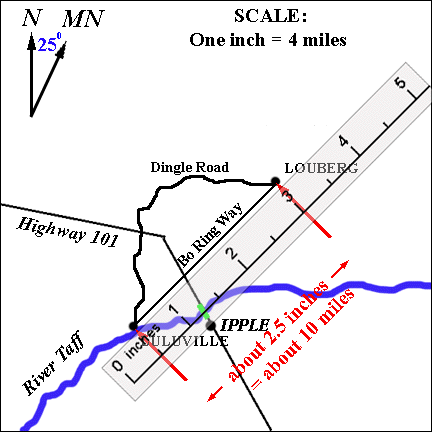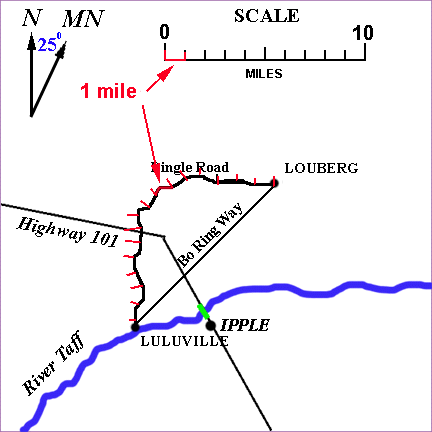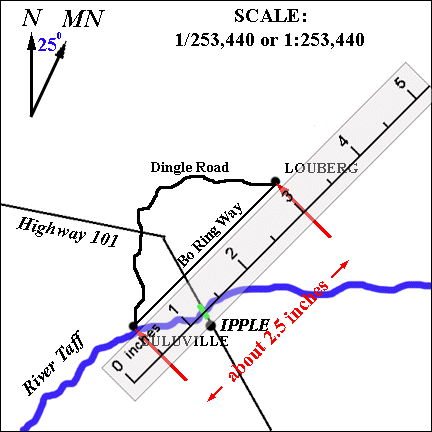
 | "How do I use scales, Lulu!? How can I determine the shortest distance from Louberg to Luluville?" |
 | "I'll tell you how! Let's deal with one type of scale at a time!" |
 | "Take a look at this map! It gives a statement of equivalency: One inch = four miles. The shortest distance between the two towns is a straight line (along Bo Ring Way)! First, place a ruler marked in inches on the map and measure how many inches separate the two towns on the map! The two towns are about 2.5 inches apart! (They may not be 2.5 inches apart on your computer monitor because the image size varies according to your screen settings.) The rest is duck soup! Since each inch on the map represents about 4 miles on the ground, Louberg and Luluville are about 2.5 inches times 4 miles per inch = 10 miles apart on the ground!" |  |
 | "On this map there's a bar scale! All you have to do is take a piece of paper, mark off miles from the bar scale onto the edge of the paper, and then hold the edge of the paper so that it lies along Bo Ring Way from Louberg to Luluville. If Louberg is at the zero miles mark (red arrow), then you can see that Luluville is about 10 miles away (other red arrow!)" |  |
 | "But suppose I want a more exciting route than Bo Ring Way? Suppose I want to go along Dingle Road?" |
 | "That's more difficult because the road is curved! You need some way to estimate distance along the curves of Dingle Way from Louberg to Luluville. There is a simple gadget called a
MAP MEASURER that can do the job for you! It has a little wheel on one end and a dial on the other. You roll the wheel end along the curves and the dial keeps a record of how far you've gone! But if you don't have a map measurer, you can use a piece of string! Take the string and lay it out along the route. Then, straighten the string out and hold it against the bar scale or a ruler!
If you don't have a piece of string, you can just mark off the units of distance as best as you can along the curves! That's what I've done on this map! I've marked off miles (taken from the bar scale) in red. It's not very accurate, but there are about 16 to 17 miles along Dingle Way between Louberg and Luluville!" |  |
 | "Cool!!" |
 | "On this map the scale is given as a representative fraction (1/253,440) and also as a ratio (1:253,440). The fraction and the ratio mean the same thing: that one unit of distance on the map represents 253,440 of the same units on the ground!" "Let's say we want to know how far it is from Louberg to Luluville along Bo Ring Way! This is how to solve the problem!!:"
|  |
© 2002
David J. Leveson